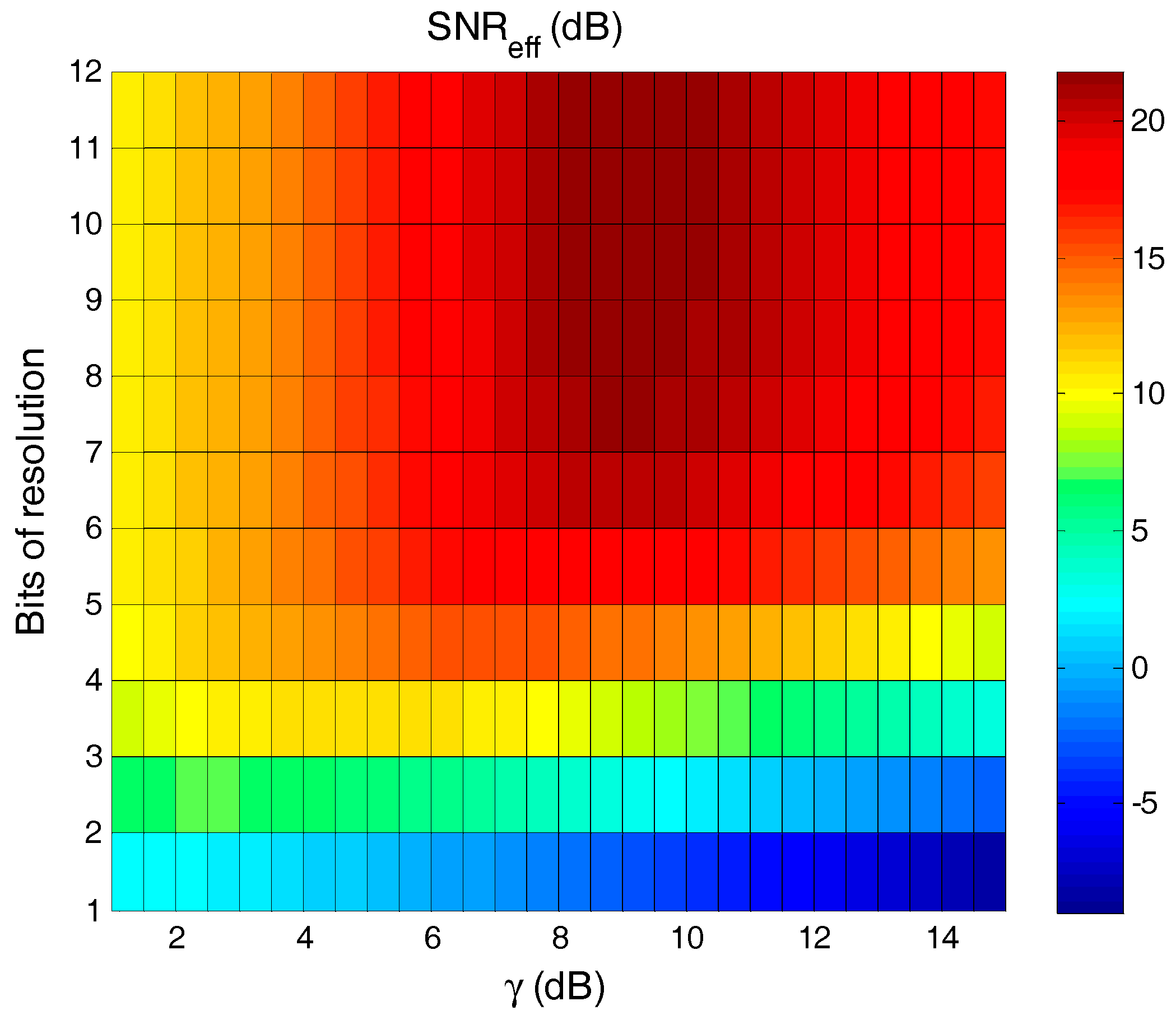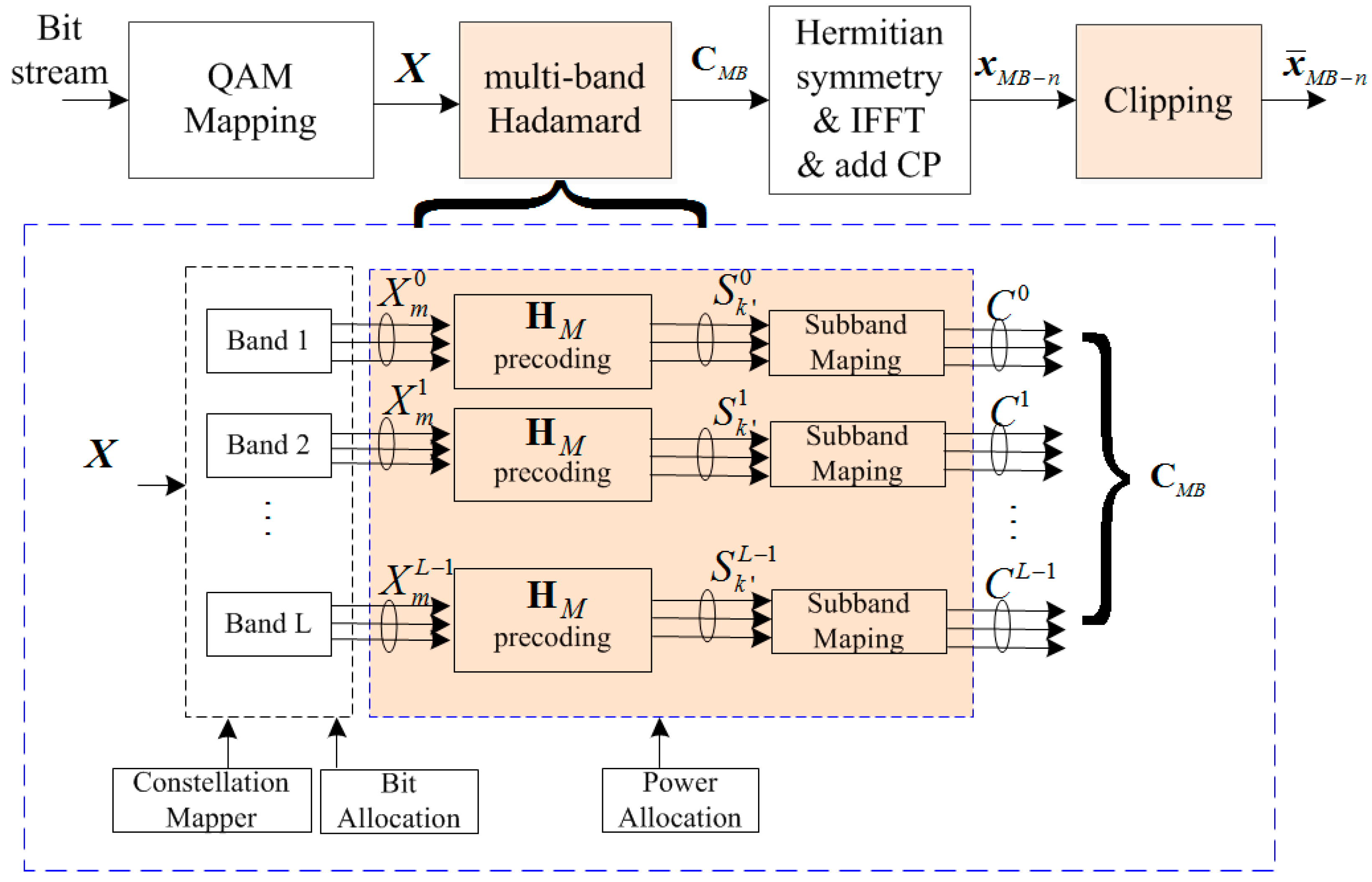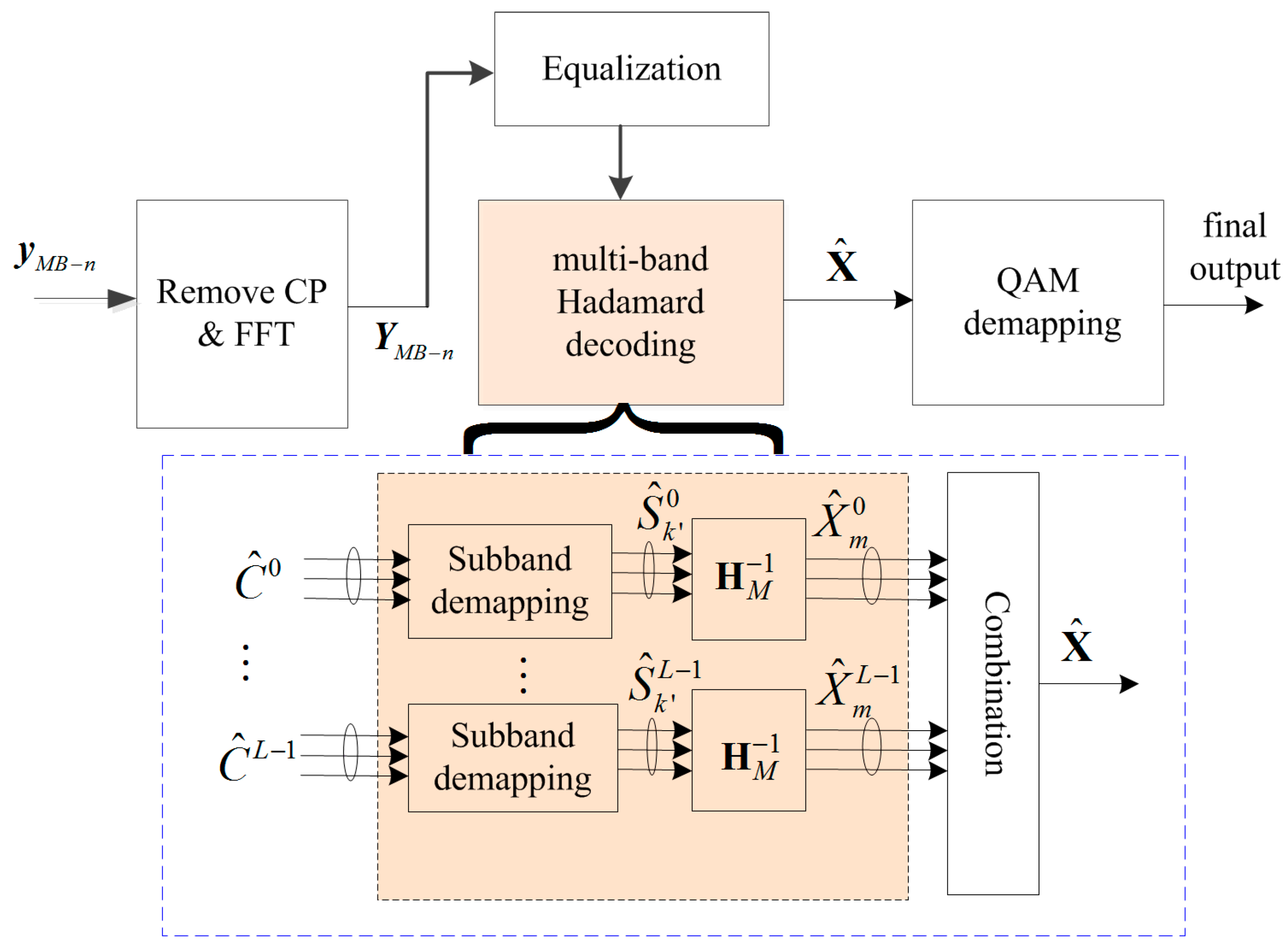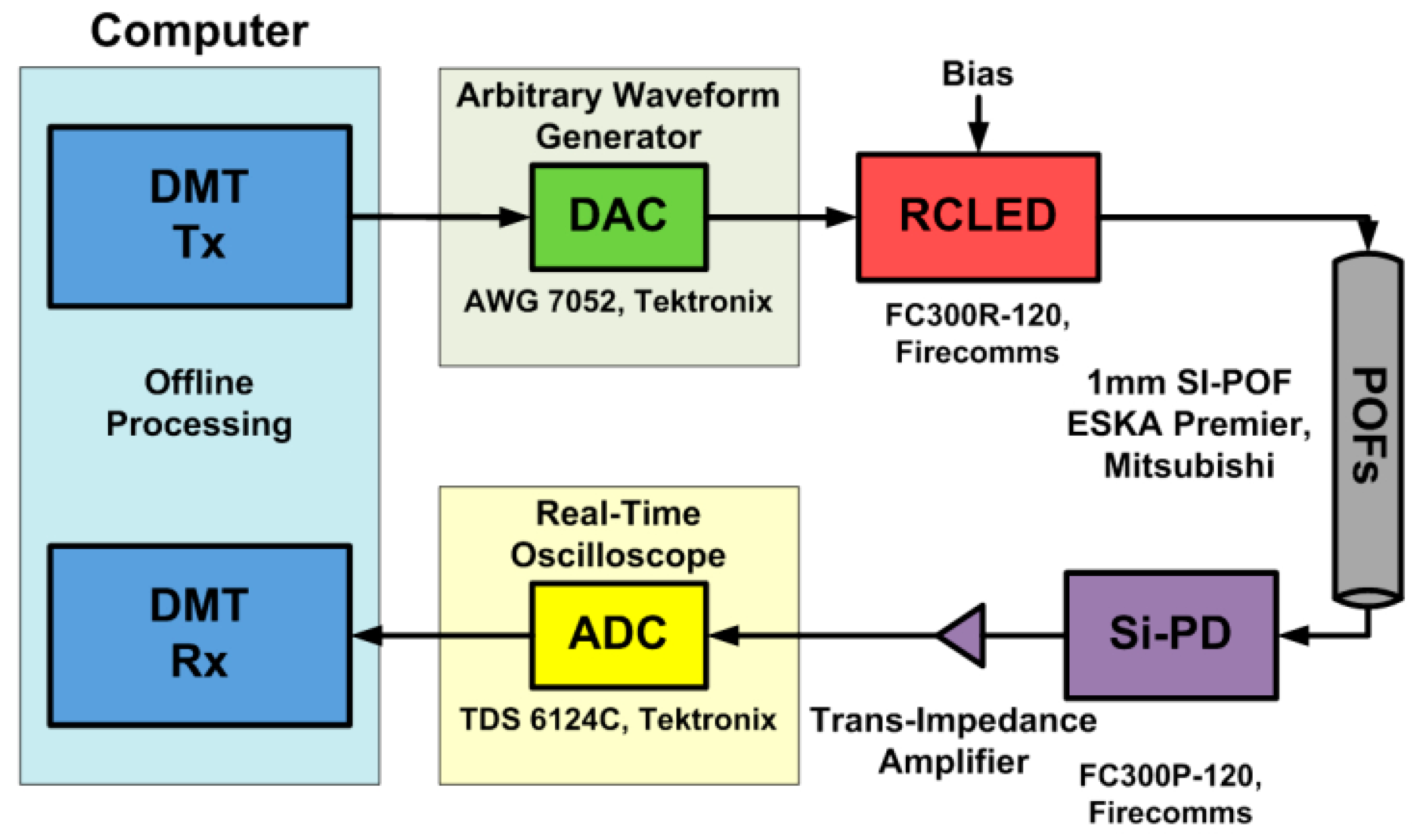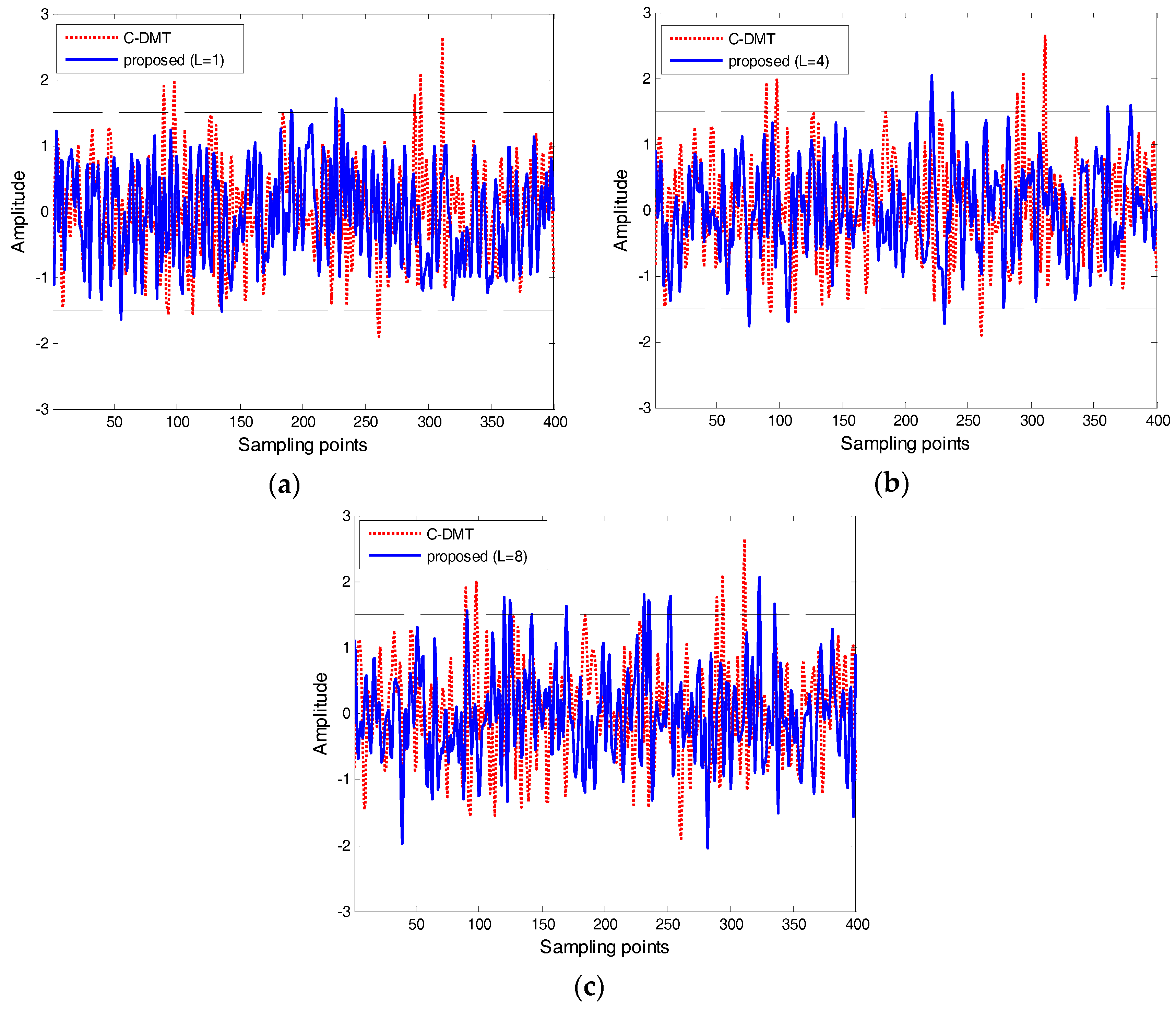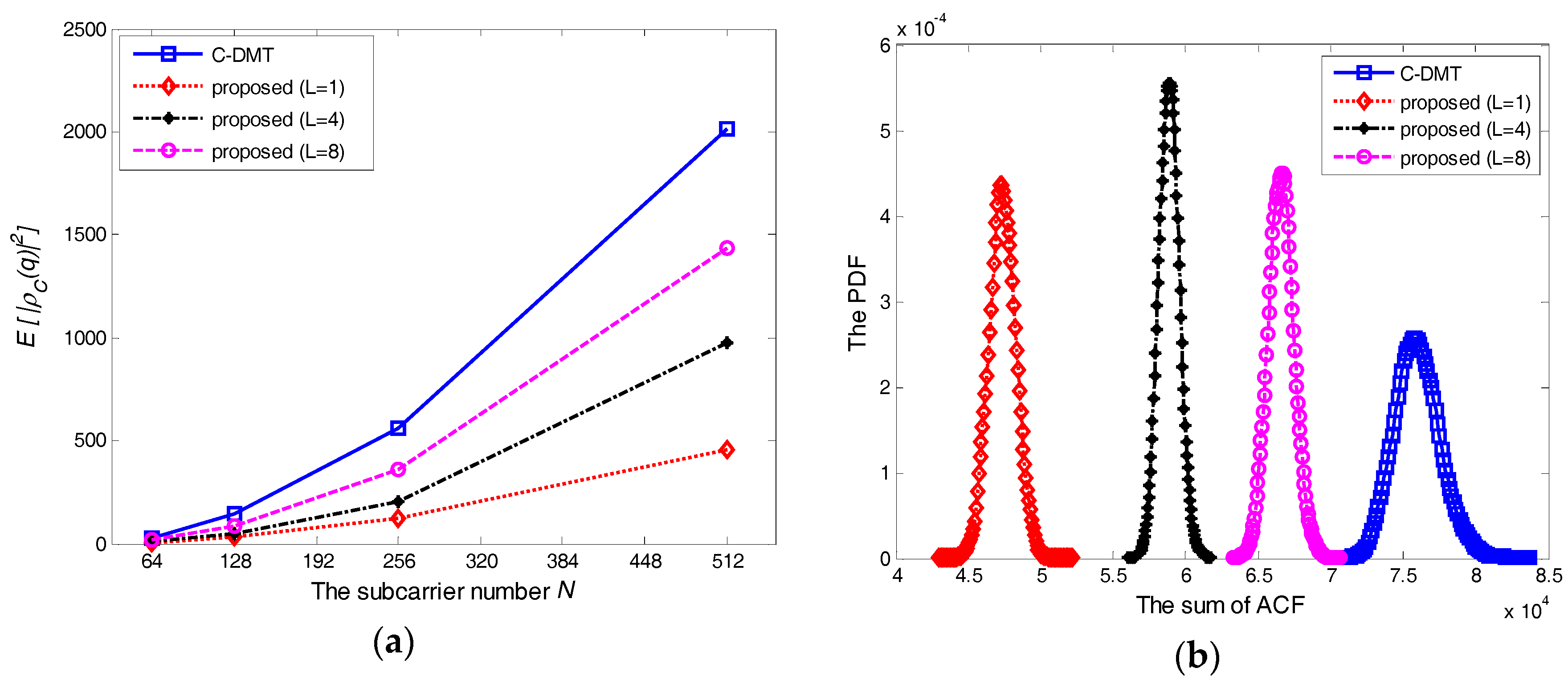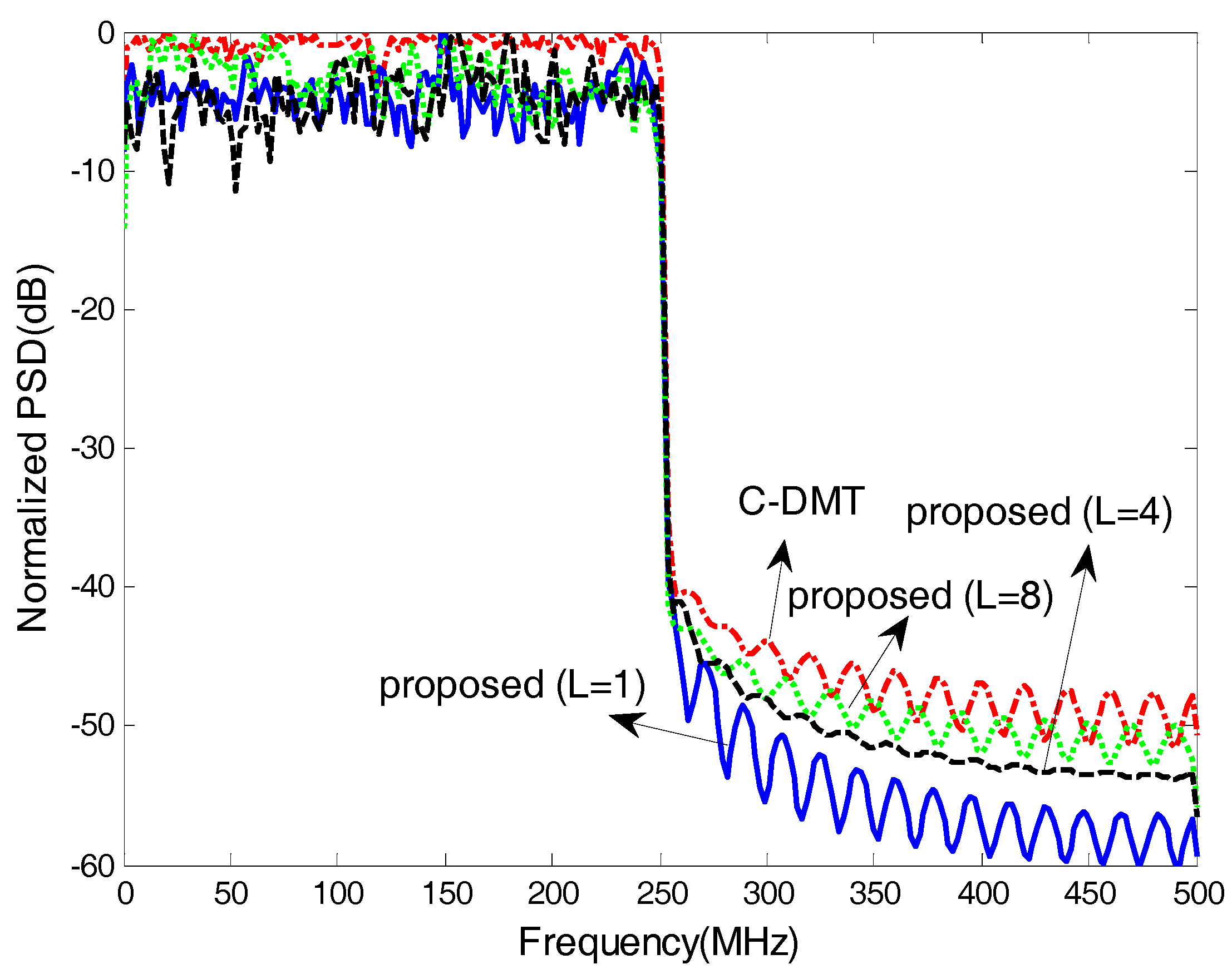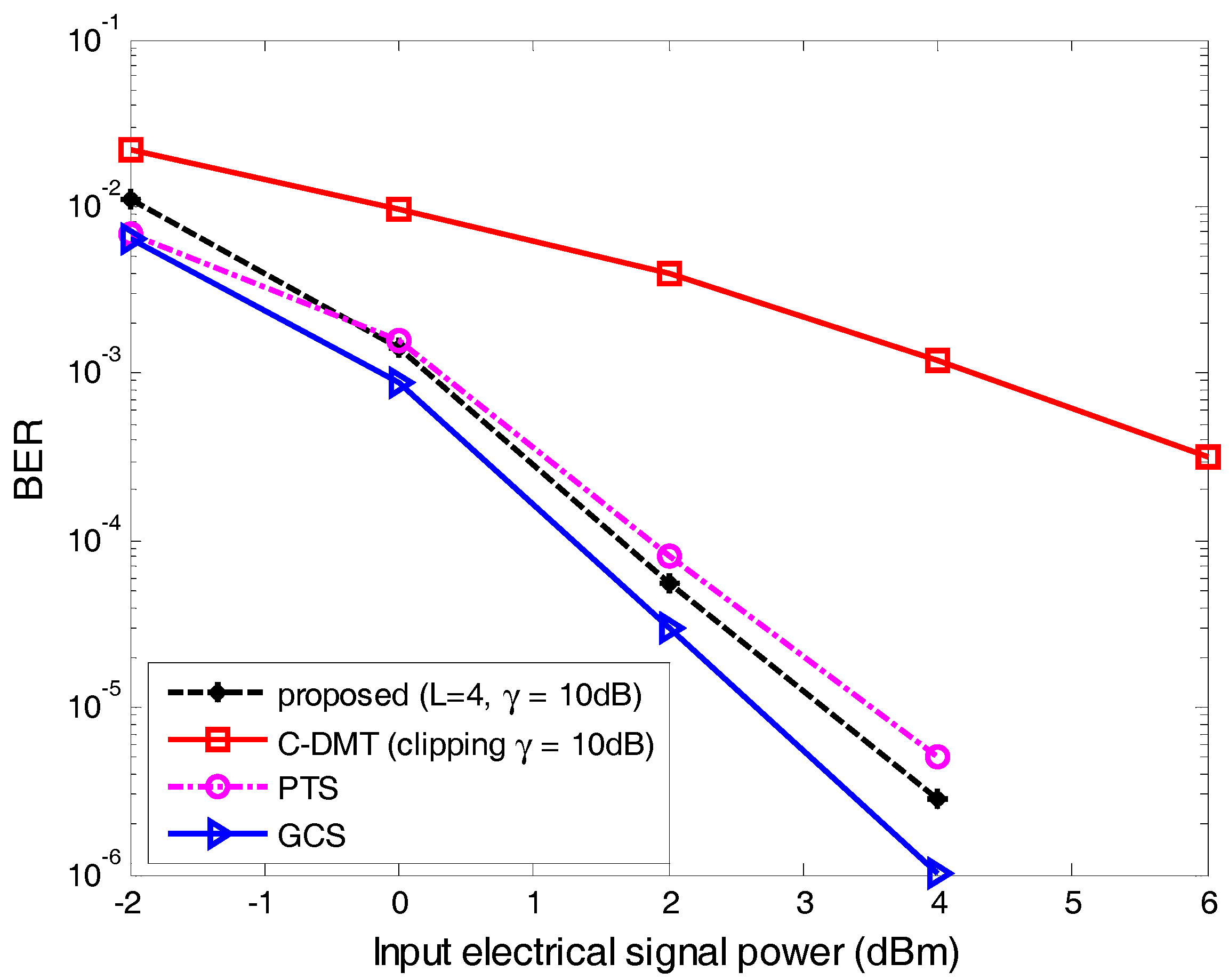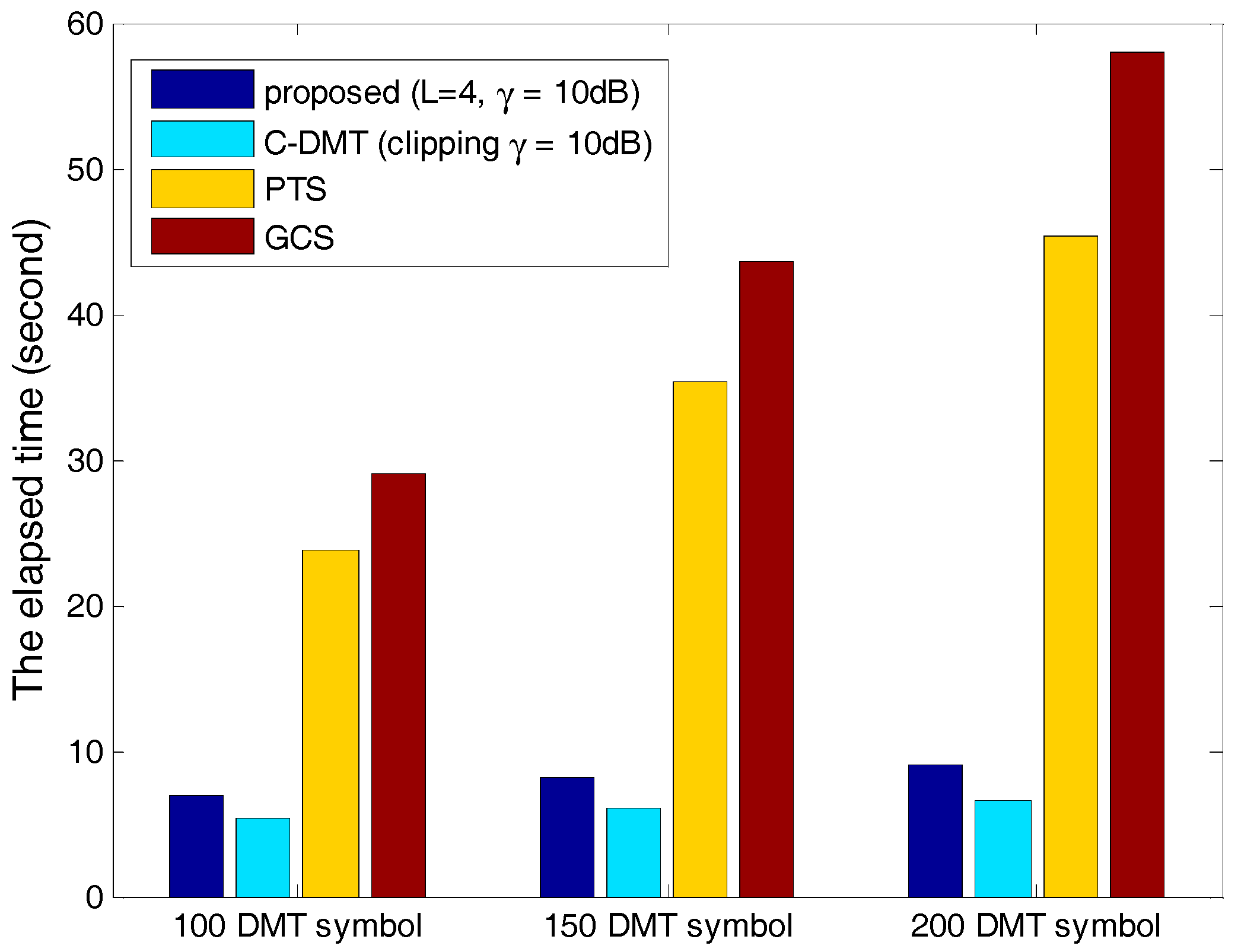1. Introduction
Orthogonal frequency division multiplexing (OFDM) is regarded as a promising modulation candidate for optical wireless communication (OWC) and polymer optical fiber (POF) as it provides a high data rate, high spectral efficiency, and high tolerance to multi-path interference [
1,
2]. A baseband OFDM with Hermitian symmetry property, as in [
3,
4], is also called discrete multi-tone (DMT). For simple and low cost consideration, the DMT can be employed in optical communications using the intensity modulation with direct detection (IM/DD) technique and bit-loading algorithm to maximize the system capacity [
4,
5,
6]. However, the DMT suffers from a high peak-to-average power ratio (PAPR) and is more susceptible to nonlinear distortions. Since the light-emitting diode (LED) has a limited linear dynamic range, the DMT signals with high PAPRs drive the LED at the transmitter to saturation, producing a greater number of nonlinear distortions and degrading the overall system performance [
7,
8,
9]. Therefore, the PAPR of the DMT should be reduced so that the LED can operate linearly and power efficiently [
10].
Several PAPR reduction techniques have been proposed for wireless communication systems [
11,
12,
13,
14,
15,
16,
17,
18]. In general, these techniques can be broadly categorized into signal distortion, distortionless, and coding schemes. Clipping, filtering and companding are well-known varieties of signal distortion schemes that directly limit the peak envelope of the transmitting signals to a desired value [
13,
14,
15]. However, these signal processing schemes result in both in-band distortion and out-of-band high frequency components, which further degrades the bit error rate (BER) performance and reduces the spectral efficiency. Selective mapping (SLM), and partial transmit sequence (PTS) are typical distortionless schemes [
16,
17,
18] that improve the PAPR distribution statistically and provide pretty good PAPR performance. However, they all have very high computational complexities and require the receivers to know the side information to retrieve the original data blocks. In addition, it is complicated to design the phase vectors for both SLM and PTSs. The coding changes their original codewords to reduce their PAPRs with high operational complexities. Tone reservation and tone injection are effective approaches to mitigate the PAPR problem [
11]. However, due to their computational complexity, the challenge is to find the optimal subset and it becomes intractable for OFDM systems with a large number of subcarriers. In addition, the transmission rate is also degraded. Schemes such as active constellation extension introduce redundancy as well [
12]. In particular, these methods used in radio wireless communication cannot be directly adopted in optical systems because of the real value property in IM/DD implementation. In contrast, discrete Fourier transform spreading (DFT-S) is an efficient method of reducing the PAPR without causing any distortion noise [
8]. Nevertheless, DFT-S-DMT still exhibits a high PAPR because of the Hermitian symmetry requirement of the IM/DD channel. In addition, each subcarrier of DFT-S-DMT obtains the same signal-to-noise ratio (SNR) after the equalization and dispreading procedure, indicating that it is unsuited to apply the bit-loading with DFT-S-DMT in the frequency selective channel to achieve overall system capacity. Moreover, DFT-S-DMT is extremely sensitive to LED nonlinearity, which limits its practical applications. The discrete Hartley transform (DHT)-spread approach exhibits a lower PAPR compared to DFT-spread techniques. However, it is only applicable to real constellations such as pulse amplitude modulation (PAM) and the PAPR reduction capability decreases with an increase in size of the PAM alphabet.
In this paper, an efficient low-complexity PAPR reduction scheme combining both multi-band (MB)-Hadamard precoding and clipping is proposed in DMT systems. The modulated symbols of a split sub-band are pre-coded by MB-Hadamard matrix to compress the peak signals of the DMT, which would mitigate the signal distortions of the following clipping operation. The received SNRs and BERs are also calculated for each split bands. The results demonstrated that the proposed scheme reduces the PAPR significantly and improves the BER performance effectively. Moreover, it matches well with the bit-loading technique to enhance the system capacity. In addition, some other famous PAPR reduction approaches are also compared and discussed.
The remainder of this paper is organized as follows. In
Section 2, we briefly present the PAPR characteristics of the DMT. In
Section 3, the effective SNR of the whole IM/DD channel considering both the clipping and the quantization is analyzed. In
Section 4, a hybrid PAPR reduction scheme is proposed to compress the peak signals and then limit the PAPR to a given threshold level.
Section 5 presents the results and discusses them, and
Section 6 concludes the paper.
Notations: the time and frequency domain vectors are represented by lower and upper boldface italic letters (e.g., and ), respectively. The element of the column vector is denoted as . Upper-case boldface letters (e.g., ) denote matrices, and , , , , and are the expectation, the transpose, complex conjugate, absolute value, real component, and symmetric conjugate operator, respectively. Let denotes the Gaussian distribution with a mean of and a variance of .
2. DMT and PAPR
With respect to a DMT symbol with
sub-carriers, the data stream is mapped onto
based on the quadrature amplitude modulation (QAM) constellation. Then, the time domain DMT signal
is generated by a
-point inverse discrete Fourier transform (IDFT), given by [
4,
5,
6,
7]:
where
conforms to Hermitian symmetry [
4] to produce the real-valued time-domain signal
. According to the central limit theorem, for
,
can be modeled as a Gaussian distribution with
.
The PAPR of
is defined as the ratio between the maximum peak power and the average power during one symbol period, which can be written as [
5,
19]
Based on the central limit theorem, we can obtain
where
,
denotes the probability, and
denotes the threshold. Therefore, the complementary cumulative distribution function (CCDF) can be calculated as
Continuous-time DMT signal
can be represented approximately by the
times oversampled
. Based on the extreme value theory, the corresponding CCDF can be calculated by
where
is the PAPR of
. Study [
11] demonstrates that selecting
is sufficient for approximating the peak value of
.
Taking the discrete-time DMT as an example, the instantaneous power of
can be calculated by
where
is defined as the aperiodic autocorrelation function (ACF) of
. For an arbitrary complex
, the following inequalities hold
and
. Thus, a PAPR with a unit mean power (
) satisfies
where
. Therefore, a close relationship exists between
and
. When the input symbols
are all equal,
is able to reach its maximum value within one symbol duration.
3. The Effective SNR
Due to both the high PAPRs of DMT signals and the finite dynamic ranges of digital-to-analog conversion (DAC) devices, digital clipping for the given upper and lower thresholds is usually performed before DAC. The clipped signal is given as [
5]
For simplicity, we consider symmetric clipping (
). The clipping ratio (CR) is defined as
The output of clipping process can be considered as the sum of
and the clipping noise
:
Nevertheless, based on the Bussgang theorem [
20] for Gaussian inputs
, the clipped signal can also be decomposed statistically into two uncorrelated parts, given by
where
is the component of clipping distortion that is statistically uncorrelated to
(e.g.,
), and
is a linear attenuation factor that can be calculated by
where
. The power of
can be obtained by
Therefore,
is a function of
and is independent of both the QAM modulation order and the size of IFFT/FFT.
is converted into the analog signal
by the DAC component. Due to the finite bit resolution
of the DAC, the quantization noise is then generated. The corresponding power can be calculated as
To modulate the LED,
is added by DC current
and obtain the final driving signals. We assume that the DMT signal is properly clipped, avoiding the LED nonlinearity. After optical channel transmission, the optical signal is detected by the optical detector, a combination of a photo diode (PD) and a trans-impedance amplifier (TIA). In most of the cases, the main sources of noise in the optical detector can be modeled as an additive white Gaussian noise (AWGN) following the distribution as
. Then, the received electrical signal is captured by analog-to-digital conversion (ADC) components with
bits of resolution. The power of the quantization noise in the ADC is given as
where
is the optical path gain coefficient. For simplicity,
,
and
are adopted in analysis. Finally, the total noise power in IM/DD channel link can be approximately measured with
. Therefore, the system performance can be evaluated by
as the ratio between the power of the useful signal and the effective noise power, expressed as
For
,
and
, the characteristic behavior of
with different
and
is depicted in
Figure 1. It can be observed that the
can achieve its maximum value regarding to the optimum clipping
for each
, e.g.,
dB for
= 8. Once the
is computed, the BER performance of the DMT system can be easily evaluated with the help of the exact close-form expression of the QAM in AWGN channel [
21]. As
Figure 1 demonstrates, the
degradation caused by the quantization is negligibly small when both
and
are greater than seven. In addition, the clipping effect dominates the system’s
as the
and
threshold is fixed. Therefore, if we perform an appropriate method for reducing the
of the input
, then, a transmitted signal with a lower
is obtained and the probability of the
exceeding a given
within one symbol duration is reduced. This indicates that the
can be lowered accordingly. Motivated by this way, a novel DMT scheme is proposed in the followings to reduce the value of
, thus indirectly reducing the PAPR and improving the
.
4. Proposed Scheme
A block diagram of the proposed scheme is shown in
Figure 2. Compared with the conventional DMT (C-DMT), two additional modules, extra MB-Hadamard precoding and clipping, are implemented at the transmitter. Hadamard is a class of Jacket matrix [
22,
23,
24] which are simple to calculate and easily element-wise inverse.
Assuming
signifies a unit
Hadamard matrix, the inverse Hadamard matrix
can be calculated directly using
For example,
where
denotes the matrix order. Note that the Hadamard matrix
with an order of the power-of-2 is adopted in this paper.
Assuming that there are
sub-carriers,
is the
data symbol in the
band. The original symbol
is spread by an
Hadamard matrix firstly, and then a new set symbols is generated with
where
is an element of
and
are sub-band mapped onto the
-point symbol vector, expressed by
where
are the modulated symbols according to the sub-band constellation mapping, expressed as
In addition, the vector
is obtained by performing Hermitian symmetry, and then fed into to the IFFT block to generate the time domain signals
. By introducing both the ACF expression from Equation (6) and the ACF sum from Equation (7), we can arrive at
Note that Equation (22) will be verified by the numerical result which is demonstrated in the
Section 5.1. Furthermore,
approaches an approximate Gaussian distribution as the value of
is large enough. The reduction in
implies a lower value of
. Thus, we obtain
According to Equation (7), there is a close relationship between and the correlations of the input frequency-domain data-symbols. Therefore, the more can be reduced, the lower the PAPR value and the higher the can be obtained by MB-Hadamard precoding. After that, the precoded DMT is added with cyclic prefix (CP) and then fed into the clipping module to further reduce the peaks. In addition, we can also perform the filtering procedure iteratively to both remove the out-of-band interference and suppress the regrowth of the peak power.
The received optical signal is transformed into an electrical signal
by the PD detector. Note that the quantization noise is negligibly small when the bit resolution is greater than seven. After the FFT and CP removal, the digital received symbol in the frequency domain can be approximately expressed with a matrix form as
where
is the frequency domain channel response,
is the
in the frequency domain and
is channel noise. In what follows, the perfectly known channel response and the perfect synchronization in the demodulation process are assumed for every received frame. After zero-forcing equalization, the equalized symbol can be expressed as
With the Hermitian symmetric data of
removed, the new received symbol
is generated. Then,
is fed into the MB-Hadamard decoding module. A diagram of the proposed decoding operation is depicted in
Figure 3, where the demodulation procedure is the reverse of those used in (19)–(21). After the sub-band demapping is completed,
is transformed by the inverse Hadamard matrix
and the final data symbol
is obtained. Then, a maximum likelihood (ML) estimator is adopted as
where
is constellation point of QAM and
is the constellation size.
When bit-loading with the desired BER
is employed, the SNR for each split band can be represented by
where
is the average noise power per subcarrier,
is the modulation gap,
and
denote the channel response and the allocated power at the
subcarrier in the
band, respectively. As we known, the clipping will introduce the offensive impulse noise among in-band and out-band. Fortunately, as seen in Equation (27), the system noise is spread averagely in each sub-band and the corresponding SNR gains will be achieved by the MB-Hadamard decoding, which is favorable for symbol estimation. When a uniform power allocation is adopted for each sub-band and the total used power is
, then
can be calculated as
. Therefore, for a frequency-selective channel such as a POF, the SNR of the entire transmission band can be written as
As shown in Equations (27) and (28), the values within the same sub-band are equal, whereas those of adjacent sub-bands are different. Under these circumstances, it is appropriate to apply the bit-loading technique to each sub-band, which represents the primary difference between the proposed scheme and the DFT-S-DMT with respect to bit loading. Finally, the BER of the MB-Hadamard decoding in the band can be approximately calculated as
